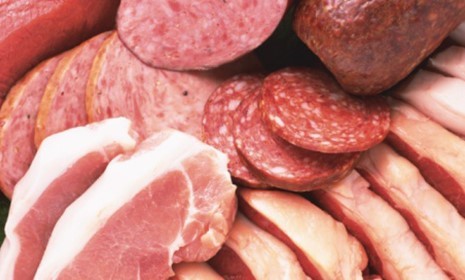
What is processed and red meat?
Processed meat is meat that’s been cured, salted or smoked to enhance the flavour or otherwise preserve in some way.
This can include bacon and turkey rashers, sausages, hot dogs (frankfurters), ham, salami, pepperoni and canned meat such as corned beef.
Red meat is any meat that’s a dark red colour before it’s cooked – such as beef, lamb, venison and goat. Pork is also classed as a red meat.
How do processed meats and red meat affect your risk of developing type 2 diabetes?
There is a link between eating too much red and processed meat and an increased risk of type 2 diabetes. This may be related to the high saturated fat in animal products, high salt levels in processed meats and / or the displacement of fruits and vegetables and cereal grains by high meat consumption.
Small amounts of red meat can be included in the diet but keep to recommended portion sizes and enjoy a variety of foods as part of a balanced diet incorporating plant-based protein foods like beans, lentils, and unsalted nuts into your diet too.
Can food processing and red meat affect health?
Red meat can be a source of protein and several vitamins and minerals including iron, zinc and vitamin B12 and it can form part of a healthy diet.
However red meat also contributes to saturated fat intakes which is linked to raised blood cholesterol levels (LDL cholesterol) which increases your risk of cardiovascular disease (CVD)
Processed meat is also high in saturated fat but contains high amounts of salt, which is linked to high blood pressure, and other potentially unhealthy ingredients. Eating too much red meat and processed meat is associated with increased risk of some cancers, in particular bowel cancer, CVD and type 2 diabetes.
For general health, the government recommends that adults should eat no more than 70g (cooked weight) of red and processed meat a day, which is about 500g per week.
If you currently eat more than 90g (cooked weight) of red or processed meat a day, you should cut down to 70g a day. However, this recommendation groups red and processed meat together and what we know is that the risk associated with processed meat is higher than red meat. So it is a good idea to limit the amount of processed meat you eat.
If you follow a healthy, balanced diet then limiting your intake of red and processed meat should not lower your intake of the nutrient’s your body needs.
Cancer associations such as the World Cancer Research Fund (WCRF) recommend limiting red meat to no more than three portions per week, which is about 350–500g (cooked weight) per week and eating very little, if any, processed meat to reduce the risk of bowel cancer, one of the most common types of cancer in the UK.
Average weights for portions of meat include:
- portion of roast beef or lamb served at a Sunday roast (3 thin-cut slices about the size of half a slice of sliced bread) - 90g
- grilled 8oz beef steak – 163g
- 2 standard British sausages, around 9cm long, and 2 thin-cut rashers of bacon or turkey rashers in a cooked breakfast (some cooked breakfasts will have black pudding too but this isn’t included in this amount) – 130g
- quarter-pound beef burger – 78g
- a slice of ham – 23g
- thin slice of corned beef – 38g.
If you eat more than 70g of red and processed meat on one day, you can eat less on the following days, so you don’t eat more than 500g per week.
Are burgers or mince processed?
Fresh burgers or minced meat are not considered processed meat – putting meat through a mincer doesn’t mean it becomes ‘processed’ unless it has been altered, for example, by the addition of additives or preservatives to extend its shelf life or flavour.
Minced meats such as fresh sausages may or may not be processed depending on their ingredients and preparation. Check the label to see if any additives or preservatives are listed such as salt, sodium nitrite and potassium nitrite.
Are meat substitutes a healthier alternative?
Vegetarian and vegan diets based on fruits and vegetables, pulses and wholegrains are associated with good health however some meat alternative products, like veggie burgers, veggie sausages and veggie mince, are not always a healthier choice compared to red and processed meat due to salt and saturated fat content and other additives.
Tofu, tempeh and soya chunks are a good source of protein and can be a healthier alternative.
Healthy swaps
It is important to eat less red and processed meats like bacon, ham sausages, beef and lamb. Try to include more beans and pulses, swap to fish or chicken/turkey and have some meat free days.
Here are some of our top food swaps to help you have a healthy diet:
- Reducing your portions of red and processed meat or reducing how often you eat these by having some meat-free days each week.
- Swap meat for pulses such as beans and lentils, eggs, fish, poultry like chicken and turkey and unsalted nuts.
- Add vegetables and beans to meals to bump up the fibre and protein content and make the meal go further. For example, replace some of the minced meat in a chilli con carne with a can of drained kidney beans in water. Or, add a tin of chopped tomatoes and tomato puree to ready-made pasta sauces.
- Beans, peas and lentils are high in fibre, helping you feel full, and don’t affect blood glucose levels too much. Also, beans and pulses are cheaper than meat, making them a budget-friendly option. 3 heaped tablespoons of beans and pulses count towards your 5 fruit and veg a day.
- Choose leaner cuts of meat and remove any visible fat or skin before cooking to lower the saturated fat content.
